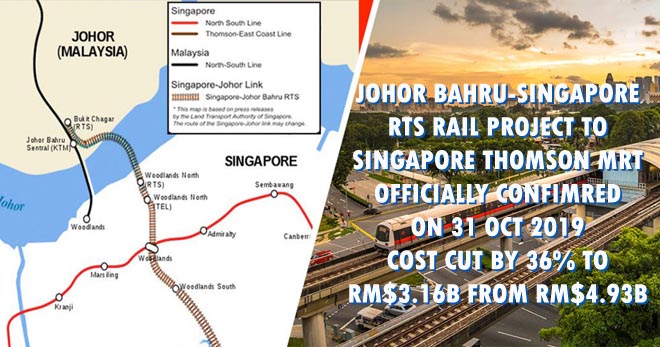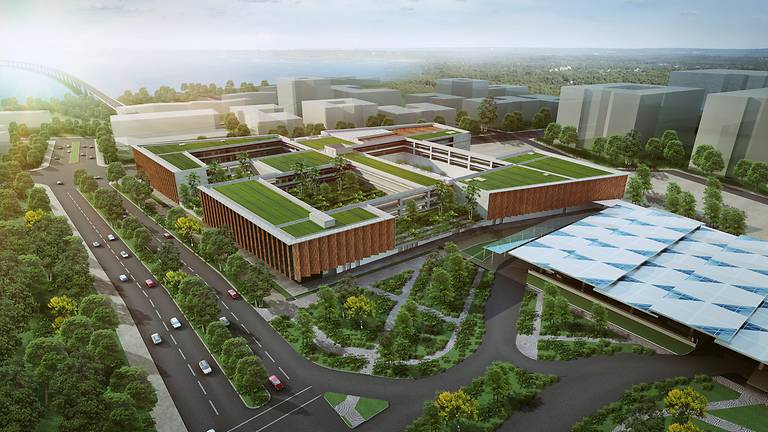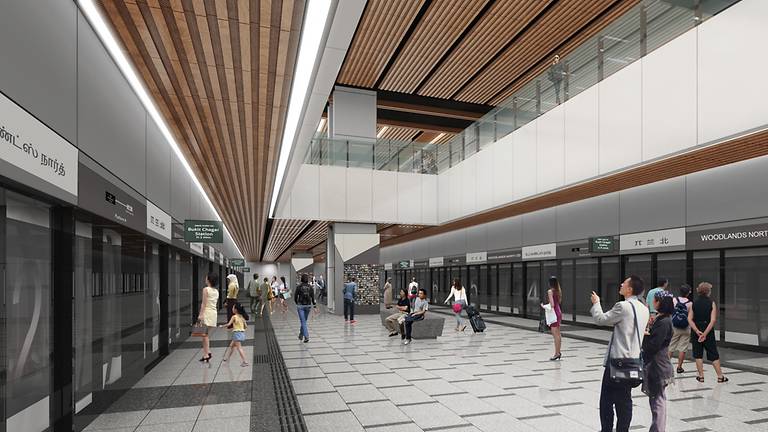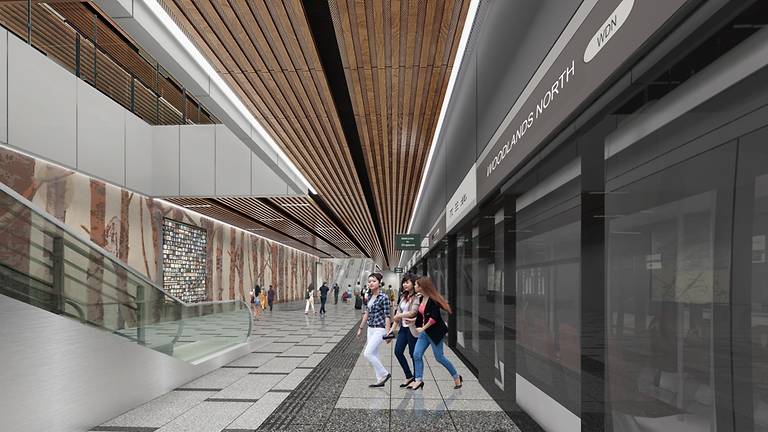JOHOR BAHRU-SINGAPORE RAPID TRANSIT SYSTEM(RTS) RAIL PROJECT TO SINGAPORE THOMSON MRT OFFICIALLY CONFIMRED ON 31 OCT 2019 COST CUT BY 36% TO RM$3.16B FROM RM$4.93B

JOHOR BARU - Malaysia has decided to proceed with a cross-border MRT link project with Singapore, with proposals to amend the project and reduce costs by 36 per cent.
Malaysian Prime Minister Mahathir Mohamad announced this on Thursday (30th Jul 2020), during a press conference held at the Bangunan Sultan Iskandar Customs, Immigration and Quarantine (CIQ) Complex. With the proposed changes, the total cost of the 4km rail project is estimated to be RM3.16 billion ($1.03 billion), instead of the original of RM4.93 billion, said the Malaysian government in a statement.Officials from both countries are currently refining Malaysia's proposals to amend parts of the bilateral agreement for the project, which was signed last year. A key feature of the revised project structure will be the involvement of the developer/owner of the Bukit Chagar land - where the Rapid Transit System (RTS) will connect to in Johor Baru - so the land cost will be waived. Malaysia is also proposing to use a LRT (Light Rail Transit) system to reduce costs. Responding to queries on the development, a Singapore Ministry of Transport (MOT) spokesman said Singapore welcomes Malaysia's decision to proceed with the project. Both sides are now discussing the changes to the project, the spokesman added. "As the changes will require amendments to the RTS Link Agreement, the discussions will take some time. Both sides are working hard on this." Speaking to reporters after the press conference, Malaysian Transport Minister Anthony Loke said the market value of the Bukit Chagar land is about RM800 million.
Mr Loke added that Malaysia is also proposing to use a LRT system for the RTS, instead of using Singapore's MRT system as originally planned. This could be similar to the LRT system in Kuala Lumpur, and will also help bring the costs of the project down, he said. On the RTS project, Tun Dr Mahathir said it will help to alleviate the congestion at the Causeway “a little bit”, pointing out what he saw as a limitation of the rail link. "Many from Johor go to Singapore in motorcycles. Unless you can put the motorcycles on the train, these people cannot have their motorcycle in Singapore," he noted.
In March this year, Malaysia requested a six-month extension to respond to Singapore on issues relating to the RTS project. Both countries later inked an agreement in May to formalise the suspension until Sept 30, with Malaysia reimbursing Singapore more than $600,000 for abortive costs incurred by the deferment. Mr Loke said at the signing ceremony that his government was looking at ways to reduce the cost of the RTS, including roping in the private sector. Malaysia later requested another month of extension till Oct 31, to which Singapore agreed.
Singapore's MOT said that the additional costs incurred during this period would be waived. But Singapore also reserves the right to claim additional costs incurred beyond Sept 30, should Malaysia request any further extension to the suspension period, said the MOT. On Thursday, Malaysia's Transport Ministry announced that its national rail operator Prasarana Malaysia will remain as the joint venture partner for the RTS. Prasarana will consult with SMRT to finalise the terms of the joint venture, it said. The Malaysian government had previously delayed confirming its joint venture partner. Both governments signed a bilateral agreement last January to build the MRT link, which will connect Woodlands North station on the Thomson-East Coast MRT Line to Bukit Chagar. The cross-border MRT link was initially targeted to begin operations by Dec 31, 2024.
The RTS project, which is based on Singapore's MRT system, would have the capacity to transport 10,000 commuters an hour in one direction during peak periods. While he said the RTS project will go ahead, Dr Mahathir separately expressed his preference for another bridge to be built between the two countries, adding that Singapore refused this proposal.
For ease of commute, the RTS Link will have co-located Custom, Immigration and Quarantine (CIQ) facilities in both the Bukit Chagar station in Johor Baru and Woodlands North station in Singapore.
"Passengers travelling in either direction will clear both Malaysia and Singapore authorities at the point of departure, and need not go through immigration clearance again at the point of arrival," the statement said.
ROUTE, MAINTENANCE AND APPOINTMENT OF INFRASTRUCTURE COMPANIES

Artist’s impression of the train platforms at the RTS Link Woodlands North Station. (Image: LTA)
The media release also said the service will cross the Straits of Johor via a 25-metre high bridge linking both the stations. It said the RTS Link will utilise the same "four core systems" as the upcoming Thomson-East Coast Line (TEL). These systems include the same trains, signalling system, communications system and the Integrated Supervisory Control System.
Heavy maintenance will be outsourced to SMRT Trains, which will operate TEL. This will be done at its Mandai Depot, although there will also be a light maintenance facility at Bukit Chagar.

Artist’s impression of the train platforms at the RTS Link Woodlands North Station. (Image: LTA)
Each country will appoint an Infrastructure Company (InfraCo) to fund, build, own, maintain and renew the civil infrastructure and stations within their territories. In Malaysia, the InfraCo will be Prasarana Malaysia Berhad, while LTA will be Singapore's InfraCo.

Artist’s impression of the train platforms at the RTS Link Woodlands North Station. (Image: LTA)
Both governments will also jointly appoint an operating company (OpCo) to own, design, build, finance, operate, maintain and renew the RTS Link's operating assets such as trains, tracks and systems.
The OpCo will pay a concession fee to the two countries in exchange for the right to collect fare revenue from operating the Link. The authorities said fares will be set on a commercial basis by the OpCo and not regulated by the two governments.
Under the terms of the agreement, the OpCo for the first concession period of 30 years, will be a joint venture between a Malaysian and a Singaporean company. These companies are Prasarana from Malaysia and SMRT Corporation in Singapore. "The companies have committed to incorporate the JV (Joint Venture) by 30 June 2018, and to sign the concession agreement by 30 September 2018. Subsequent concessions will be awarded through open tender," the statement said.
7 things to know about the upcoming Johor Baru-Singapore Rapid Transit System Link
1. THERE WILL BE A TRAIN EVERY 8 MINUTES
When it is ready by Dec 31, 2024, commuters can hop on a train every eight minutes on average. Trains will eventually arrive every four minutes on average during peak periods. The line will start with five trains, and gradually have a total fleet of seven trains. The link can carry up to 10,000 passengers per hour in each direction. This means 60,000 additional commuters will be able to cross the Causeway during peak hours. Currently, an average of 300 passengers travel in each direction per hour using the daily shuttle train service between Woodlands and Johor Baru.
2. START YOUR JOURNEY AT WOODLANDS NORTH
The line will link Bukit Chagar station in Johor Baru, near Sentral train station, to the Singapore terminus in Woodlands North, where commuters can transfer to the upcoming Thomson-East Coast MRT Line (TEL). The TEL is expected to open in phases from 2019 to 2024, and will comprise 31 stations stretching from Woodlands in the North to Sungei Bedok.
3. PASSENGERS NEED TO CLEAR CUSTOMS ONLY ONCE
The link will have a joint customs, immigration and quarantine facility at both terminus stations. Passengers who are crossing the border will need to clear customs and immigration only when they depart from either Singapore or Malaysia.
4. THE 4KM LINK WILL CROSS THE STRAITS OF JOHOR VIA A 25M-HIGH BRIDGE
The tracks will cross the Strait of Johor in a straight line rather than curving over water, taking into account the Johor Sultan's earlier reservations about the project. It will make a bend over land in Malaysia instead.
5. FARES WILL BE SET BY JOINT VENTURE COMPANY
Fares will be set by the joint venture company between SMRT and Prasarana Malaysia. It will not be regulated by the two governments.
6. THE END OF KTM SHUTTLE TRAIN
Within six months after the link starts operations, the Keretapi Tanah Melayu Tebrau (KTM) Shuttle will cease. The KTM train service has been running 26 daily trips since June 1 last year to cope with higher demand.
7. POSSIBLE REDEVELOPMENT OF WOODLANDS CHECKPOINT
Last August, Mr Khaw said the opening of the link will allow the Woodlands Checkpoint to be redeveloped, after the train shuttle service ends and land is freed up. "Then, hopefully, this problem of the Causeway jam can be significantly mitigated or even eliminated," he had said.
(新山31日10月2019讯)越堤族千盼万唤的马新捷运(RTS)终于来了!
在获得柔州苏丹依布拉欣陛下捐献位于新山市区的武吉查卡地段,以及重新检讨整个计划的建筑成本后,大马将耗资31亿6000万令吉重新启动马新捷运计划,比原本预估的49亿3000万令吉,省下17亿7000万令吉或36%。
交通部长陆兆福今午偕同首相敦马哈迪、财政部长林冠英、经济事务部长拿督斯里阿兹敏、内政部长丹斯里慕尤丁、柔佛州务大臣拿督萨鲁丁嘉玛等巡视新山依斯干达关税、移民厅及检疫大厦后指出,一度被暂缓的马新捷运计划经过交通部对项目结构、规模和规具体格进行多番考察和修订后,内阁已于10月18日批准继续执行相关计划。 他指出,马新捷运计划造价得以降低的其中一大特点是,捷运终站所座落的武吉查卡地段的发展商或地主,以豁免地价的方式,资助和促使计划得以继续延续。陆兆福指出,有关地段总值8至9亿令吉,因获得献地,让政府省下一笔资金,带动整体建造费下调。 "修改后的马新捷运项目一大特点,即武吉查卡地段的地主愿意以豁免地价方式将地段献给政府,加上完善了建筑和铁路系统成本,为政府节省下了大量的资金,因此才拥有财务能力继续完成这个计划。" 武吉查卡地段的持有人就是柔佛苏丹依布拉欣陛下。陛下早前已透过柔佛王宫发表声明,表明若所拥有的武吉查卡地段确实会进行马新捷运系统计划,陛下将不征收任何费用,将涉及计划的地段交给政府发展。惟条件是马新捷运系统计划一定要尽快落实,解决民众往返马新两地的苦恼。
陆兆福说,在马新捷运计划搁置期间,交通部进行了一系列由政府官员、行业专家及利益相关者进行的审查及评估活动,最终以最佳的方案继续计划。大马政府也感谢新加坡政府的积极配合与协助。 "整个计划的总开销比前朝政府执政时,所提出的建造费省下17亿7000万令吉。" 他也说,马新两国官员目前正在完善马来西亚的修正提案,以确保最新的修正与在2018年1月签署的双边协议中规定的项目结构和规格(BA)保持一致。
成立联营公司
马新捷运计划将继续由国家基建公司(Prasarana Malaysia Bhd)与新加坡SMRT Corp成立一家联营公司,共同操作捷运系统工程项目。 该联营公司将负责设计、建设、融资、营运、维护和更新RTS Link营运资产,如火车、轨道和系统。 根据交通部发出的文告,捷运公司(MRT Corp(与其子公司必须受委托为铁路基建公司,负责基建工程桥梁、车站及关税、移民厅及检疫中心(CIQ)建筑。
捷运公司与PMB在巴生谷,都拥有发展及营运铁路的纪录,这两家公司都是由大马政府通过财政部企业拥有。 交通部长表示,政府致力于解决马新长堤的交通拥堵问题,相信马新捷运将为成千上万越堤族提供快速,可靠和负担得起的服务,节省通勤时间。